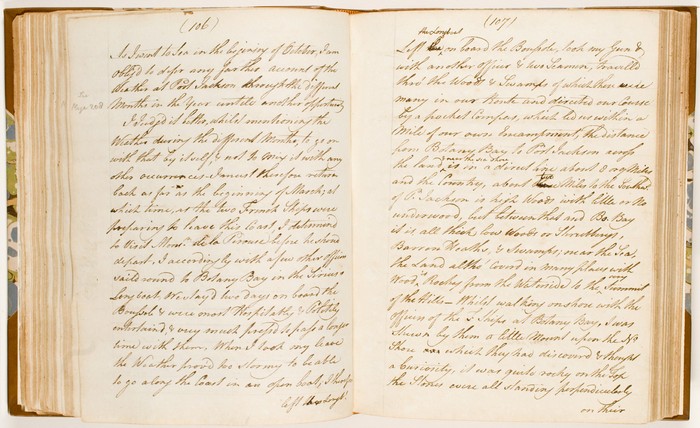Soon after the First Fleet arrived in Port Jackson in January 1788, Hunter led an expedition to explore and chart the Parramatta River, which made soundings as far as Iron Cove, Five Dock Bay and Hen and Chicken Bay on the Parramatta River (the Library holds the original chart).The expedition may have seen the first contact take place between the British and the Indigenous owners of the land, the Wangal Clan, in 1788. William Bradley's log says that this contact took place while Hunter was having breakfast; it is remembered in the name of the suburb, Breakfast Point.
On pages 74 and 75 of his journal, Hunter gives an account of the expedition and makes the following observations about the local Aboriginal people:
"A few days after my Arrival with the transports in this Harbor, I sett off with a Six oard boat & small boat, intending to make as a good a Survey as circumstance wou’d admit, I took to my assistance Mr. Bradley (1st Lt.) Mr. [indecipherable] the master, & a young Gentleman of the quarter deck. During the time we were Employ’d on this business we had frequent meetings with different parties of the Natives, whom we found at this time very Numerous, which I confess I was a little surprised to find, after what had been said of them in the Voyage of the Endeavour, for I think it is observ’d in the Account of that Voyage, that at Botany Bay they had seen very few of the natives and that they appeard a very Stupid & incurious people. We saw them in very Considerable numbers & they appear’d to us to be a lively & inquisitive Race; They are a Straight, thin, but well made people rather small in their limbs but very active, they Examin’d with the utmost attention & [indecipherable] great astonishment at the different Coverings we had on, for they certainly consider’d our Cloaths as so many different Skins, and the Hatt a part of the head; they were pleasd with such trifles we had to give them, and always appeard Chearfull & good humour’d, they danced & sung with us, & imitated our Words and Motions as we did them; they generally appeard arm’d with a Lancet & short stick which [indecipherable] in throwing it; this Stick is about three feet long, is flattened on one side, has a hook of Wood at one end, & a flat shell let into a split in the Stick at the other, & fastend with Gum; Upon the flat side of this Stick the lance is laid, in the upper end of which is a small hole into which the point of the hook of the throwing stick is fixd, this [indecipherable] the lance on the flat side of the stick, then [indecipherable] the Lance thus fixd in one hand with the forefinger & thumb over it to prevent its falling off sideways, Holding fast the throwing stick they discharge with considerable force & in a very good direction to the Distance of about sixty and twenty yards *
[*Note in margin - I have seen a strong young fellow throw the lance full ninety yards which till then, I did not believe possible I measurd the distance –]”



 Back to list
Back to list